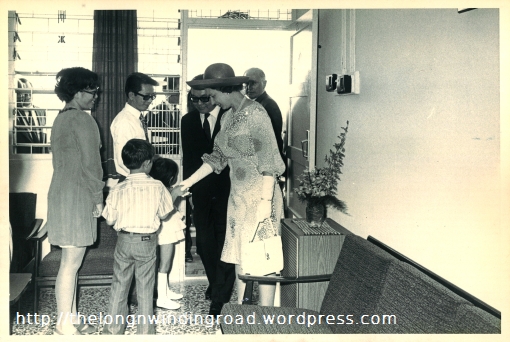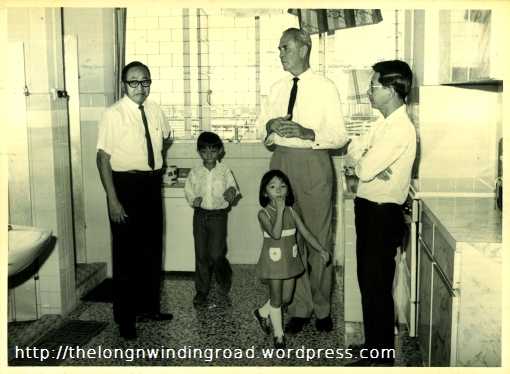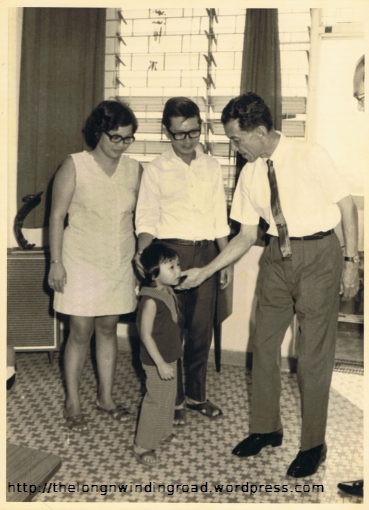I very recently set foot in a flat that had once been my childhood home, one that holds not just the memories of my formative years, but also of the wonderful moments of what had been a very eventful childhood. The flat in Toa Payoh, is one that I have not been in since I moved out to another in Ang Mo Kio some three and a half decades ago and although I have visited the block of flats several times in more recent years, I never did summon the courage to knock on its door – a door, just like the gate that protects it and the common corridor facing windows next to it, is the same one that I had left behind. Plus, it did look as if it wasn’t occupied.

The bedrooms’ mosaic flooring – unchanged since the time my parents put it in when we first moved in some 45 years ago … a mosaic which holds many memories of my childhood.
The opportunity to revisit the flat came by way of a message on my mobile. A Mediacorp Channel 8 team producing a variety show that is currently being aired on local television, United Neighbours Society, with whom I had been in touch with over the use of old photographs, asked if I could be interviewed at the flat. The flat was one of two which HM Queen Elizabeth II took a look at during a visit to Singapore in 1972 – a visit the team were keen to include in the Toa Payoh episode of the show, each episode of which is set in a different residential estate in Singapore and includes snippets of the particular estate’s past. An opportunity that I never thought would come to see my childhood home again had presented itself and I had to agree, which I did without much hesitation. With the current owner of the flat kindly agreeing to have his flat filmed, I soon found myself stepping through a doorway I had last stepped through in 1976.

Shaking hands with the Queen. The visit of the Queen to the flat in 1972 was one of the highlights of a wonderful childhood.
It’s hard to describe how I felt stepping into the flat … a surge of varying emotions went through me. Although furnished very differently from when I had lived in it, there was more that was familiar than that wasn’t familiar. One of the first things that struck me was how much hadn’t changed. One was the green terrazzo flooring that my parents had put in – in anticipation of the Queen’s visit, complete with the radiused light green skirting which I at that instance remembered I used to push my model die-cast cars along and against.
The ceiling was still the old familiar ceiling – just a little worn with age, as were the front grilles and the kitchen cabinets with the same Formica lining … Right at the back of the kitchen area is probably where most of the changes to the flat had be made. I could see the obvious signs of the upgrading work that the block of flats has since undergone – upgrading work which regretfully altered the clean façade of the block, and took away the rooftop viewing gallery and the wonderful open spaces below the block. The windows and grilles had been replaced and the bathroom and WC (in two separate rooms as it common to see in those days) had been modernised. I looked up – I had forgotten how high the ceiling at the back was – the space right at the back of the kitchen had when the flat was in its original condition been a service balcony – separated by a wall with a door and louvered windows. My parents had the wall removed and windows installed at the balcony which then became an extension to the kitchen.

Setting foot into a flat that once had been my childhood home brought with it a flood not just of the memories it contains, but also a surge of emotions in me.
The kitchen is one that holds many special memories. Memories that came flooding back to me as I surveyed the kitchen included the many occasions when I helped my mother with her baking –making pineapple tarts which she always made for Christmas and Chinese New Year. This was something I always looked forward to – I was particularly fond of using the pastry cutter which included a wooden block that fit into the metal shell that acted as the cutter to mould the little recess in which the filling went into. The filling would then already have been prepared – a tedious task that involved grating pineapples and cooking and then draining the filling before it was ready to be used. Another thing I enjoyed was cutting the little strips of left over pastry, forming then into shapes and letters and placing them on top of the filling before the tarts were baked in the oven.
Another memory that came back to me of the kitchen is one of the days that preceded the dumpling festival. It was in the space by the entrance from the hall – a spot where for a while my father had placed his fish tank, where a bamboo pole would be laid across two chairs from which lengths of bamboo twine was suspended. It was where we sat on low stools to pack the dumplings – glutinous rice with a filling of pork spiced in the Peranakan style with a peeled chestnut added wrapped in a bamboo leaf in the shape of a tree sided pyramid, which could then be secured using the bamboo twine before we put them in the steamer.
Stepping into the bedroom, the one that was separated from the common corridor by a wall with the same two panels of louvered windows still there which we normally kept closed, brought back many memories as well – many bittersweet. The bedroom, still with the same blue and white mosaic flooring that was put in when we first moved in, was one which I shared with my late maternal grandmother, one in which I have my happiest memories of my interactions with her. She had a high metal framed bed fitted with four posts and an upper frame on which she fitted a mosquito net or kelambu as she had referred to it, on the side of the room away from the doorway. It was from her bed that she related the many stories I heard of her life and from her. It was also on her bed where she would apply when seemed then like her cure-all – Minyak Kayu Putih as she called it – Eucalyptus oil to my stomach area whenever I had experienced a stomach ache.

Windows and grilles which had been unchanged for 45 years – on the windows of the hall and the bedroom which I had used.
The room with its original door and windows also intact, somehow looked a lot smaller than it appeared to me as a child. Standing there, it was hard to imagine how we had fitted a metal framed double-decker bed, the lower bunk of which I had used, on the other side, as well as my grandmother’s old style cabinet cum dresser and another cupboard at the doorway end and an altar (which once caught fire) in the top corner above my grandmother’s cupboard. Staring at the flooring – there seemed to be a lot more memories – many which are personal, which seemed to be held in the repeated patterns that the blue and white tiles form, that came back … some bringing a tear to my eye.

Playing in the hall … the mosaic flooring that my parents had originally fitted can be seen – the same one which still exists in the bedrooms.
The very pleasant gentleman that now owns the unit, is the same one who had bought the flat over from the HDB after we had moved (rules then did not allow HDB flats to be traded on the open market). I did have a photograph of him taken with me after filming was completed, as I did take a few photographs of the flat with his kind permission – out of respect for the owner’s privacy I will not post the photographs except the ones which do not reveal too much. I took the opportunity to also have a chat with him and one of the things that I did learn from him was that the lady who went door-to-door selling bubur pulut hitam (a dessert of black glutinous rice served with a topping coconut milk) – a fond memory I have of my days in Toa Payoh (I would always look forward to her coming), still does it. He says that she must now be at least in her 80s …

The kitchen and the cabinets which are still there seen during Sir William Goode’s visit in September 1972.
The time soon came when I had to say goodbye to my childhood home once again. Although it was with some reluctance, I did leave also with a sense of contentment. It wasn’t just one that comes with the comfort of seeing a place that I was emotionally attached to as a child and one that has retained many physical reminders of the world I was familiar with, but also one that comes with the many hidden memories that my visit to the flat has awakened in me.






















































































